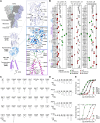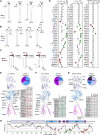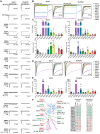Gain-of-function and loss-of-function variants in GRIA3 lead to distinct neurodevelopmental phenotypes
- PMID: 38038360
- PMCID: PMC11068105
- DOI: 10.1093/brain/awad403
Gain-of-function and loss-of-function variants in GRIA3 lead to distinct neurodevelopmental phenotypes
Abstract
AMPA (α-amino-3-hydroxy-5-methyl-4-isoxazole propionic acid) receptors (AMPARs) mediate fast excitatory neurotransmission in the brain. AMPARs form by homo- or heteromeric assembly of subunits encoded by the GRIA1-GRIA4 genes, of which only GRIA3 is X-chromosomal. Increasing numbers of GRIA3 missense variants are reported in patients with neurodevelopmental disorders (NDD), but only a few have been examined functionally. Here, we evaluated the impact on AMPAR function of one frameshift and 43 rare missense GRIA3 variants identified in patients with NDD by electrophysiological assays. Thirty-one variants alter receptor function and show loss-of-function or gain-of-function properties, whereas 13 appeared neutral. We collected detailed clinical data from 25 patients (from 23 families) harbouring 17 of these variants. All patients had global developmental impairment, mostly moderate (9/25) or severe (12/25). Twelve patients had seizures, including focal motor (6/12), unknown onset motor (4/12), focal impaired awareness (1/12), (atypical) absence (2/12), myoclonic (5/12) and generalized tonic-clonic (1/12) or atonic (1/12) seizures. The epilepsy syndrome was classified as developmental and epileptic encephalopathy in eight patients, developmental encephalopathy without seizures in 13 patients, and intellectual disability with epilepsy in four patients. Limb muscular hypotonia was reported in 13/25, and hypertonia in 10/25. Movement disorders were reported in 14/25, with hyperekplexia or non-epileptic erratic myoclonus being the most prevalent feature (8/25). Correlating receptor functional phenotype with clinical features revealed clinical features for GRIA3-associated NDDs and distinct NDD phenotypes for loss-of-function and gain-of-function variants. Gain-of-function variants were associated with more severe outcomes: patients were younger at the time of seizure onset (median age: 1 month), hypertonic and more often had movement disorders, including hyperekplexia. Patients with loss-of-function variants were older at the time of seizure onset (median age: 16 months), hypotonic and had sleeping disturbances. Loss-of-function and gain-of-function variants were disease-causing in both sexes but affected males often carried de novo or hemizygous loss-of-function variants inherited from healthy mothers, whereas affected females had mostly de novo heterozygous gain-of-function variants.
Keywords: AMPA receptor; GRIA; GRIA3; clinical biomarker; genotype-phenotype.
© The Author(s) 2023. Published by Oxford University Press on behalf of the Guarantors of Brain. All rights reserved. For commercial re-use, please contact reprints@oup.com for reprints and translation rights for reprints. All other permissions can be obtained through our RightsLink service via the Permissions link on the article page on our site—for further information please contact journals.permissions@oup.com.
Conflict of interest statement
The authors report no competing interests.
Figures





References
-
- Raman IM, Trussell LO. The kinetics of the response to glutamate and kainate in neurons of the avian cochlear nucleus. Neuron. 1992;9:173–186. - PubMed
-
- Silver RA, Traynelis SF, Cull-Candy SG. Rapid-time-course miniature and evoked excitatory currents at cerebellar synapses in situ. Nature. 1992;355:163–166. - PubMed
-
- Hayashi Y, Shi SH, Esteban JA, Piccini A, Poncer JC, Malinow R. Driving AMPA receptors into synapses by LTP and CaMKII: Requirement for GluR1 and PDZ domain interaction. Science. 2000;287:2262 LP–2262267. - PubMed
Publication types
MeSH terms
Substances
Grants and funding
LinkOut - more resources
Full Text Sources
Molecular Biology Databases

